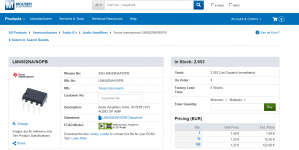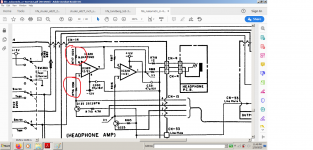Does anyone have a source for Philips/Signetics NE5532As in DIP form? I could probably also use an ON Semi one if in DIP form. I'm trying to avoid the T.I. chips and their renowned distortion compared to the originals.
Can only find TI DIP8 ones.
By renouned distortion you mean the slightly higher distortion above 10kHz? Doug Self measures this as 0.0008% to 0.0012% at 20kHz, compared to 0.0007% for other brands. (2nd ed. of "The Design Of Active Crossovers")
On Semi SOIC8 ones on a SOIC->DIP breakout is a possible way to go.
By renouned distortion you mean the slightly higher distortion above 10kHz? Doug Self measures this as 0.0008% to 0.0012% at 20kHz, compared to 0.0007% for other brands. (2nd ed. of "The Design Of Active Crossovers")
On Semi SOIC8 ones on a SOIC->DIP breakout is a possible way to go.
I have all the makes of ne5532, 34, and i mean all of them and tried all the possible circuits with them...You're loosing your time, believe me for once! Go with lm4562 instead and you won't regret it with your Soundcraft...None of the circuits you have there using bipolar op-amps is in trouble with the input current noise.
You're off again, as usual:...Go with lm4562 instead and you won't regret it with your Soundcraft...None of the circuits you have there using bipolar op-amps is in trouble with the input current noise.
Originally Posted by dotneck335

Now the only thing remaining is the bus drivers---which are currently NE5532s, which really are fine ICs for the most part. I could also replace those with LM4562s, which are quieter, cleaner, and faster.
I don't think there's a whole lot to gain - aren't these the output drivers with their 22k and 100k resistors anyway? LM4562s are only going to be more noisy under these conditions (as you should find out if you plug in their voltage and current noise densities with these part values - I'm getting about 4 dB more output noise), and NE5532s are fine line drivers as-is.
The originals may be a bit hard to find these days as they haven't been made in like 15 years, following a fire at a French fab in 2003.
The ON Semis might be the closest to the original nowadays... I noticed that the Fairchilds are supposed to be drawing only 6 mA typ. The TIs are good load drivers and rather better-behaved if somewhat slower than they should be, so maybe not the worst output drivers especially where used inverting (in which case the chip is hard to fault).
Where there already are 5532s now I'd just leave them as-is. Maybe add some local rail bypassing. I think upgrading the TL072s with e.g. OPA1642 as planned should do for now.
The ON Semis might be the closest to the original nowadays... I noticed that the Fairchilds are supposed to be drawing only 6 mA typ. The TIs are good load drivers and rather better-behaved if somewhat slower than they should be, so maybe not the worst output drivers especially where used inverting (in which case the chip is hard to fault).
Where there already are 5532s now I'd just leave them as-is. Maybe add some local rail bypassing. I think upgrading the TL072s with e.g. OPA1642 as planned should do for now.
At this point, I totally agree; that's what I'll do with my Soundcraft mixer. I'm actually looking for ON Semi NE5532s in DIP form to put in my tape machines, as they are just enough of an upgrade over the NJM4559s to be worthwhile. I did mange to find some old NOS Philips NE5534s, which should arrive soon; but they didn't have any 5532s.Where there already are 5532s now I'd just leave them as-is. Maybe add some local rail bypassing. I think upgrading the TL072s with e.g. OPA1642 as planned should do for now.
BTW, thanks again for all your help on the CFP mic pre!
Last edited:
...hence mediocre, at it's best, for audio…
I've successfully replaced many 4559's by TI's NE5532's in different stages (RIAA phono, line level, active Baxandall tone control...) of audio gear.
Best regards!
I've successfully replaced many 4559's by TI's NE5532's in different stages (RIAA phono, line level, active Baxandall tone control...) of audio gear.
Best regards!
But watch out for the RFI immunity issues - sometimes as a voltage follower the LM4562 can pick up radio stations if the inverting input is directly connected to the output (internal oscillations?) 100 ohm resistor in the feedback path apparently cures this. (As reported by Doug Self in his Active Crossover book)
and those are really nothing but 741s stuck in a dual package.Yeeech!!njm4559 are low offset versions of njm4558...
...hence mediocre, at it's best, for audio…
That's excellent advice; thanks. I have had trouble in the past with 4562s, and never thought of doing that.But watch out for the RFI immunity issues - sometimes as a voltage follower the LM4562 can pick up radio stations if the inverting input is directly connected to the output (internal oscillations?) 100 ohm resistor in the feedback path apparently cures this. (As reported by Doug Self in his Active Crossover book)
really?!and those are really nothing but 741s stuck in a dual package.Yeeech!!
3 MHz BW, 1 V/us SR is much better than a ua741and those are really nothing but 741s stuck in a dual package.Yeeech!!
Not that different to a TL082
Well, maybe the NJM part is better, but the T.I. 4558 datasheet says "The RC4558 device is a dual general-purpose operational amplifier, with each half electrically similar to the μA741, except that offset null capability is not provided."
The Fairchild era RC4558 datasheet declares 3 MHz BW and 0.8 V/us TYPICAL
Not as good as the NJM part, but still better than a 741
The current TI RC4558 declares 3 MHz typ, 1.1 V/us min, 1.7V/us typ
This parts spec has been all over the place, but looking at some old CD and DVD player boards, the TI flavour is the one used.
Not as good as the NJM part, but still better than a 741
The current TI RC4558 declares 3 MHz typ, 1.1 V/us min, 1.7V/us typ
This parts spec has been all over the place, but looking at some old CD and DVD player boards, the TI flavour is the one used.
I'm actually using the 1k max value prescribed for common mode canceling technique resistors in his "Small signal" book.For some njm's you can safely use higher values up to 100kohm depending on application.100 ohm resistor in the feedback path apparently cures this. (As reported by Doug Self in his Active Crossover book)
@dotneck
the only problem with answering you is that you clearly try to use some people's authority to dispute others when you're simply wrong...which actually is a vulgar way of manipulating people to get information from them and never being grateful for what you get to anyone actually cause you feel like a GOD distributing "powers" to his slaves...
In one topic you're "grateful" for getting more comprehensive datasheet for NJM parts, although i only used Google search engine to source them in just a few seconds and then providing some other information that took years for me to gather cause I'm not such a genius as yourself, then you open another topic disputing the same NJM lack of comprehensive datasheet .I personally find your behavior insulting and this is my last intervention in any of your topics.Sometimes slaves just prefer to change their masters...
This is my last intervention in your topics...
Attachments
Last edited:
Yeah, I think that's the best approach. I got a quote from Heisener for DIP form NE5532As; then I asked if the ICs were genuine ON Semi devices, and then all of a sudden the price tripled. I don't think I'll do business with them.On Semi SOIC8 ones on a SOIC->DIP breakout is a possible way to go.
- Home
- Design & Build
- Parts
- Philips/Signetics NE5532A

